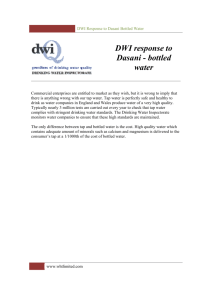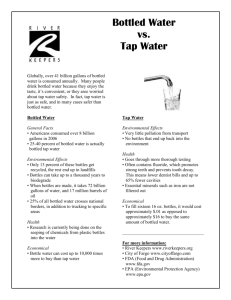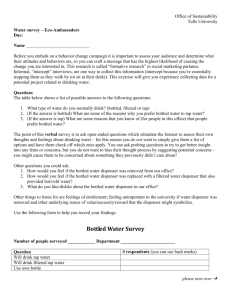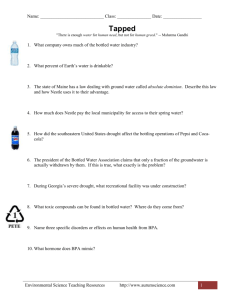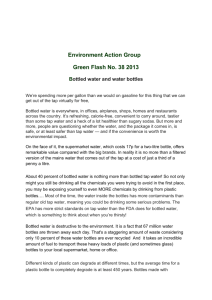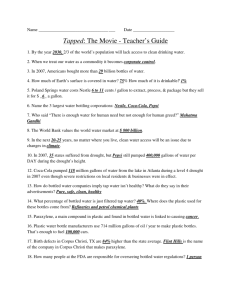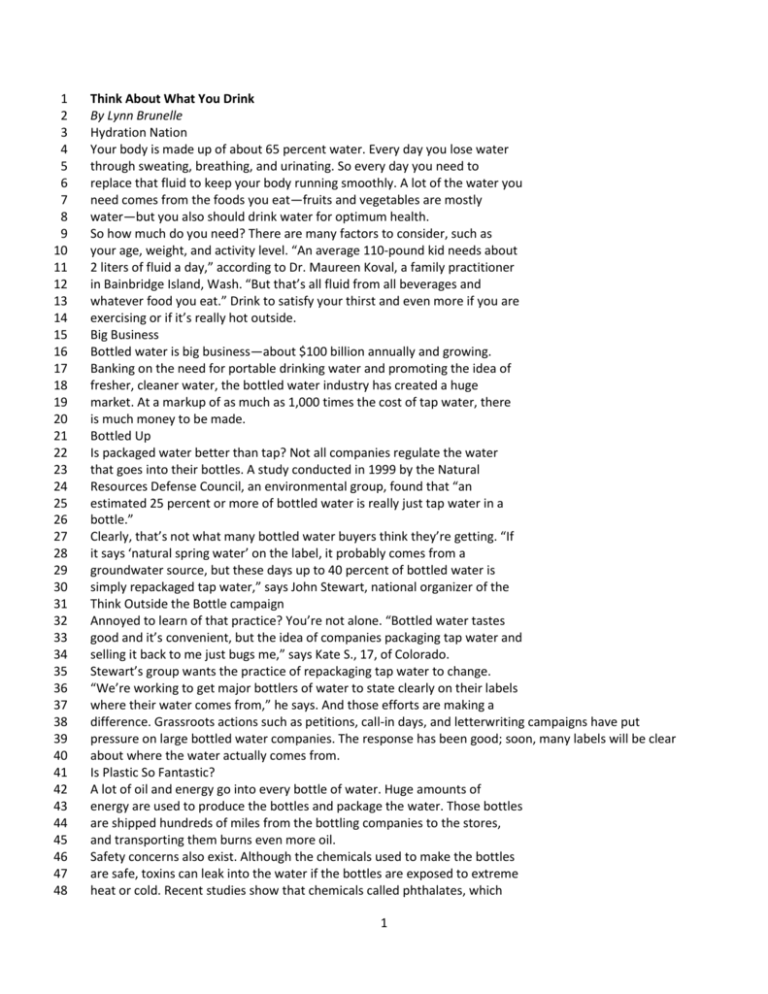
1
2
3
4
5
6
7
8
9
10
11
12
13
14
15
16
17
18
19
20
21
22
23
24
25
26
27
28
29
30
31
32
33
34
35
36
37
38
39
40
41
42
43
44
45
46
47
48
Think About What You Drink
By Lynn Brunelle
Hydration Nation
Your body is made up of about 65 percent water. Every day you lose water
through sweating, breathing, and urinating. So every day you need to
replace that fluid to keep your body running smoothly. A lot of the water you
need comes from the foods you eat—fruits and vegetables are mostly
water—but you also should drink water for optimum health.
So how much do you need? There are many factors to consider, such as
your age, weight, and activity level. “An average 110-pound kid needs about
2 liters of fluid a day,” according to Dr. Maureen Koval, a family practitioner
in Bainbridge Island, Wash. “But that’s all fluid from all beverages and
whatever food you eat.” Drink to satisfy your thirst and even more if you are
exercising or if it’s really hot outside.
Big Business
Bottled water is big business—about $100 billion annually and growing.
Banking on the need for portable drinking water and promoting the idea of
fresher, cleaner water, the bottled water industry has created a huge
market. At a markup of as much as 1,000 times the cost of tap water, there
is much money to be made.
Bottled Up
Is packaged water better than tap? Not all companies regulate the water
that goes into their bottles. A study conducted in 1999 by the Natural
Resources Defense Council, an environmental group, found that “an
estimated 25 percent or more of bottled water is really just tap water in a
bottle.”
Clearly, that’s not what many bottled water buyers think they’re getting. “If
it says ‘natural spring water’ on the label, it probably comes from a
groundwater source, but these days up to 40 percent of bottled water is
simply repackaged tap water,” says John Stewart, national organizer of the
Think Outside the Bottle campaign
Annoyed to learn of that practice? You’re not alone. “Bottled water tastes
good and it’s convenient, but the idea of companies packaging tap water and
selling it back to me just bugs me,” says Kate S., 17, of Colorado.
Stewart’s group wants the practice of repackaging tap water to change.
“We’re working to get major bottlers of water to state clearly on their labels
where their water comes from,” he says. And those efforts are making a
difference. Grassroots actions such as petitions, call-in days, and letterwriting campaigns have put
pressure on large bottled water companies. The response has been good; soon, many labels will be clear
about where the water actually comes from.
Is Plastic So Fantastic?
A lot of oil and energy go into every bottle of water. Huge amounts of
energy are used to produce the bottles and package the water. Those bottles
are shipped hundreds of miles from the bottling companies to the stores,
and transporting them burns even more oil.
Safety concerns also exist. Although the chemicals used to make the bottles
are safe, toxins can leak into the water if the bottles are exposed to extreme
heat or cold. Recent studies show that chemicals called phthalates, which
1
49
50
51
52
53
54
55
56
57
58
59
60
61
62
63
64
65
66
67
68
69
70
71
72
73
74
75
76
77
78
79
80
81
82
83
84
85
86
87
88
89
90
91
92
93
94
95
96
may disrupt hormones, can seep into bottled water from the plastic
container. Not much is known yet about the potential health risks, but you
may be getting more than you bargained for when you drink from a plastic
bottle. What happens to the plastic after you drink the water? The good news is that plastic is
recyclable. The bad news is that not all bottles are recycled. “Less than 20 percent get recycled,” says
Stewart. “More than 4 billion pounds of plastic end up in landfills and along the roadside every year.”
The Big Drip
The federal Food and Drug Administration (FDA) sets standards for bottled
water, and the Environmental Protection Agency sets standards for public
water supplies. But their rules aren’t the same. As a result, there can be a
big difference in how bottled water and tap water compare in terms of
safety.
“Tap water comes from reservoirs and is tested for contaminants hundreds
of times a month,” says Stewart. “Public water systems also have annual
reports available so you can check on the health of your local tap water.
Less than 1 percent of the FDA’s time and resources is spent on regulating
bottled water, so many of the companies are left to police themselves.”
Chemical Additives
Does your tap water taste funny? Public water can have small amounts of
good or not-so-good chemicals that can change the taste. Chlorine is added
in many public water systems to kill germs, but it can leave an aftertaste.
Another chemical, fluoride, may be added to public water because it is
helpful in preventing tooth decay.
Not all chemicals are intentionally put in, though. Pipes can shed lead or
rust. In certain parts of the country, runoff from nearby farms can taint the
water. A good filter can help. Tabletop pitchers with charcoal filters can absorb and remove chemicals
and leave the tap water tasting fresh. Other filters placed directly on the tap can remove chemicals and
small particles before they pass through the faucet.
Tapping In
So the next time you’re thirsty, drink up. But think about what you drink.
“We’re not saying bottled water shouldn’t exist,” says Stewart. “In
emergency situations it’s great. But clean drinking water is a human right
and a public good, one you shouldn’t have to pay so much for.”
If only bottled water is available, drinking it is OK. Staying healthy is
important. But if you have a choice, reaching for a glass or finding a fountain
may make a big difference for the planet.
Just ask Isaac G., 14, of Washington. He says: “I drink both tap and bottled
water, but I choose tap water whenever I can. It just makes more sense for
me—and for the environment.”
Drinking water is one of the healthiest things you can do for your
body. There’s no argument about that. But what to drink?
Bottled water is everywhere. However, even though the labels and
commercials tell you that this or that brand of water is the purest, is it really
better for you? Is drinking bottled water better for the environment?
Tap water may be better for the environment, and it certainly is cheaper,
but is tap water really clean and healthy?
Non-fiction: Think About What You Drink
© 2012 ReadWorks®, Inc. All rights reserved.
2
97
98
99
100
101
102
103
104
105
106
107
108
109
Article: Copyright © 2011 Weekly Reader Corporation. All rights reserved.
Weekly Reader is a registered trademark of Weekly Reader Corporation.
Used by permission.
4
Thirsty yet? Here are a few things to think about the next time you
need a drink.
Do the Math
Tap water is cheap. Bottled water? Not so much. A half-liter bottle costs
about $1 on average. So that’s $2 a liter. At approximately 3.8 liters in a
gallon, you’re up to about $7.60. That’s roughly three times the cost of a
gallon of gas. When you buy bottled water, the cost isn’t in the water (which
is tap water in many cases) but in the packaging, the shipping, the
marketing, and the profit to the company bottling it. Do you think the convenience of bottled water is
110
worth the price?
3

